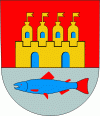Oulu
 |
Oulu is one of the largest cities in the world for its latitude. It is the fourth northernmost city in the world with over 100,000 inhabitants, with the three others located in Russia. Oulu is the northernmost large city that belongs in the Western cultural sphere.
Due to its large population and geopolitically economic and cultural-historical location, Oulu has been called the "capital of Northern Finland". Oulu is also considered one of Europe's "living labs", where residents experiment with new technology (such as NFC tags and ubi-screens) on a community-wide scale. Despite only ranking in the top 2% universities, the University of Oulu is regionally known in the field of information technology. Oulu has also been very successful in recent urban image surveys; in a study published by the Finnish Economic Survey in 2008, it received the best ranking of large cities in image ratings across the country, including ratings from respondents in all provinces. In the 2023 T-Media survey, Oulu was tied with Kuopio as the second most attractive city in Finland, while Tampere taking first place.
Once known for wood tar and salmon, Oulu has evolved into a major high-tech centre, particularly in IT and wellness technology. Other prominent industries include wood refining, chemicals, pharmaceuticals, paper, and steel.
Oulu has been chosen as the European Capital of Culture for 2026.
The city is named after the river Oulujoki, which originates in the lake Oulujärvi. There have been a number of other theories for the origin of the name Oulu. One possible source is a word in the Sami language meaning 'flood water', but there are other suggestions. At minimum, the structure of the word requires that, if originally given by speakers of a Uralic language, the name must be a derivative. In all likelihood, it also predates Finnish settlement and is thus a loanword from one of the now-extinct Saami languages once spoken in the area.
The most probable theory is that the name derives from the Finnish dialectal word oulu, meaning "floodwater", which is related to e.g. Southern Sami åulo, meaning "melted snow", åulot meaning "thaw" (of unknown ultimate origin). Two other word families have also been speculated to be related. The first is seen in the Northern Savo dialectal word uula and its Sami counterpart oalli, both meaning "river channel". The second is the Uralic root reconstructed as *uwa, meaning "river bed" (reflected as vuo in modern Finnish, also in derivatives such as vuolas "heavy-flowing"). To either of these roots, some Sami variety would have to be assumed having added further derivational suffixes.
Map - Oulu
Map
Country - Finland
 |
 |
| Flag of Finland | |
Finland was first inhabited around 9000 BC after the Last Glacial Period. The Stone Age introduced several different ceramic styles and cultures. The Bronze Age and Iron Age were characterized by contacts with other cultures in Fennoscandia and the Baltic region. From the late 13th century, Finland became a part of Sweden as a consequence of the Northern Crusades. In 1809, as a result of the Finnish War, Finland became part of the Russian Empire as the autonomous Grand Duchy of Finland, during which Finnish art flourished and the idea of independence began to take hold. In 1906, Finland became the first European state to grant universal suffrage, and the first in the world to give all adult citizens the right to run for public office. After the 1917 Russian Revolution, Finland declared independence from Russia. In 1918, the fledgling state was divided by the Finnish Civil War. During World War II, Finland fought the Soviet Union in the Winter War and the Continuation War, and Nazi Germany in the Lapland War. It subsequently lost parts of its territory, but maintained its independence.
Currency / Language
| ISO | Currency | Symbol | Significant figures |
|---|---|---|---|
| EUR | Euro | € | 2 |
| ISO | Language |
|---|---|
| FI | Finnish language |
| SV | Swedish language |















